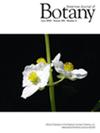The contribution of carbon budget to masting intervals in Veratrum album populations inhabiting different elevations
Abstract
Premise
Mast flowering/seeding is often more extreme in lower-resource environments, such as alpine compared to lowland habitats. We studied a masting herb that had less extreme masting at higher elevations, and tested if this difference could be explained by higher photosynthetic productivity and/or lower reproductive investment at the higher-elevation sites.
Methods
We examined the relationship between flowering intervals and carbon budget (i.e., the balance between reproductive investment and annual carbon fixation) in a masting herb, Veratrum album subsp. oxysepalum, across five lowland and six alpine populations in northern Japan. We evaluated the previous flowering histories of individual plants based on rhizome morphology and analyzed the masting patterns of individual populations. Total mass of the reproductive organs, as a proxy of reproductive investment, was compared between the lowland and alpine populations. Annual carbon fixation was estimated on the basis of photosynthetic capacity, total leaf area per plant, and seasonal transition of light availability.
Results
Interval between high-flowering years was shorter and total reproductive investment was smaller in the alpine than in the lowland populations. Owing to its high photosynthetic capacity and continuous bright conditions, annual carbon fixation per plant was 1.5 times greater in alpine habitat than in lowland habitat. These results suggest that V. album alpine populations have shorter flowering intervals than lowland populations due to faster recovery from energy loss after reproduction.
Conclusions
Our study demonstrated that masting intervals in V. album populations can be explained by habitat-specific carbon budget balances.

 求助内容:
求助内容: 应助结果提醒方式:
应助结果提醒方式:


